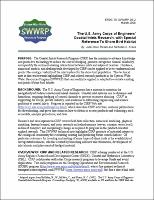Please use this identifier to cite or link to this item:
https://hdl.handle.net/11681/3498Full metadata record
| DC Field | Value | Language |
|---|---|---|
| dc.contributor.author | Rosati, Julie Dean | - |
| dc.contributor.author | Kraus, Nicholas C. | - |
| dc.date.accessioned | 2016-03-16T15:45:13Z | - |
| dc.date.available | 2016-03-16T15:45:13Z | - |
| dc.date.issued | 2006-03 | - |
| dc.identifier.uri | http://hdl.handle.net/11681/3498 | - |
| dc.description | Technical Note | - |
| dc.description.abstract | Purpose: The Coastal Inlets Research Program (CIRP) has the mission to advance knowledge and predictive technology to reduce the cost of dredging, promote navigation channel reliability, and quantify the sediment-sharing interactions between inlets and adjacent beaches. Guidance, numerical models, and desktop tools developed by CIRP can be applied to better understand and predict the ecologic viability of the inlet system for the shore bird population. This technical note is directed towards highlighting CIRP and related research products in the System-Wide Water Resources Program (SWWRP) that can readily be applied or adapted to evaluate existing and predict future bird habitat. | - |
| dc.description.sponsorship | System-Wide Water Resource Program (U.S.) | - |
| dc.description.sponsorship | Coastal Inlets Research Program (U.S.) | - |
| dc.publisher | Environmental Laboratory (U.S.) | - |
| dc.publisher | Engineer Research and Development Center (U.S.) | - |
| dc.relation | http://acwc.sdp.sirsi.net/client/en_US/search/asset/1004825 | - |
| dc.subject | Shore birds | - |
| dc.subject | Coastal zone management | - |
| dc.subject | Sediment transport | - |
| dc.title | The U.S. Army Corps of Engineers' coastal inlets research, with special reference to shore bird habitat | - |
| dc.type | Report | en_US |
| Appears in Collections: | Technical Note | |
Files in This Item:
| File | Description | Size | Format | |
|---|---|---|---|---|
| TN-SWWRP-06-2.pdf | 1.89 MB | Adobe PDF |  View/Open |